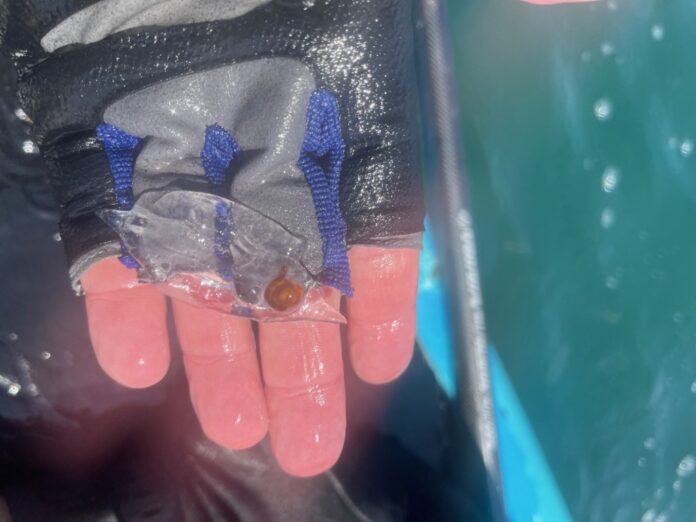In a once-in-a-decade occurrence, a type of plankton known as salp is making the waters off La Jolla home, and thousands have been seen by local swimmers and fishermen.
While La Jolla Parks & Beaches President Bob Evans was swimming off La Jolla Cove on July 27, “they were all over the place” near the buoys, he said.
“I had no idea what they were until I was talking with a few friends back onshore,” Evans said. “They had seen the salp presence over the previous week, but [July 27] was by far the most concentrated to date in the water.”
Similarly intrigued, local fisherman Kurt Hoffman said he saw thousands of the gelatinous creatures during a recent expedition off Boomer Beach.
“I started to notice a lot of what I thought were these little eggs in the water and I finally picked one up,” Hoffman said. “I thought it was some type of shark egg or something because it looked like an embryo, but it’s an actual living organism. It was amazing how many were out there. … In my 50 years on the water, I had never seen this species.”
Moira Décima, curator of the Pelagic Invertebrate Collection at UC San Diego’s Scripps Institution of Oceanography in La Jolla who studied salps in recent years, said they are a unique species of plankton with a “boom and bust” population cycle.
Décima said salps appear around La Jolla “enough for people to remember, but it’s not common. They are cool and weird-looking and not that common a thing to encounter.”
She said plankton is any organism that can’t swim against the current. Thus, though salps are bigger than other types, they are plankton.
“They are high in water , so they contrast with other types of plankton that are higher in lipids and protein, and [they] have high growth rates, partially because they can produce biovolume quickly and alternate between a sexual phase and asexual phase of reproduction,” Décima said.
Each salp can asexually create a chain of up to 800 clones that remain attached while swimming and feeding, and each individual grows. They first mature as females, and each produces an embryo through sexual reproduction and gives birth, after which it turns male. The sexual fertilization comes from males produced by older chains.
“Other plankton have a more regular reproductive cycle, not that alternating one,” Décima said. “[Salps] can pump out clones and reach that high abundance. But there has to be ample food in the water.”

The water has to be on the cooler side for salps to thrive, she said. They sometimes can be found off La Jolla during La Niña years.
During the La Niña climate pattern, stronger-than-usual trade winds push more warm water toward Asia. Upwelling increases off the west coast of the Americas, bringing cold water to the surface.
“[Salps] … are not always here,” Décima said. “These … are more of a cold-water species. The last time there was a salp bloom was in 2012, and they were up and down the coast. That was a La Niña year.”
The National Oceanic and Atmospheric Administration says there’s a 70 percent chance of La Niña conditions emerging from August to October and a 79 percent chance they will persist from November to January.
Thus, the salps’ presence off La Jolla “could be a sign of higher plankton presence and the La Niña weather conditions,” Décima said.
Fish, seabirds and whales can eat salps, but they are not often consumed for food. But their role in the ecosystem goes further than the food web.
“They have the claim to fame of producing heavy fecal waste, so they can increase the amount of carbon that can be moved through the ocean,” Décima said. “In order for carbon to be sequestered, it has to be deep. [Sinking fecal waste] is an efficient way to move carbon to the deep.”
She said “there is a lot of interest” in whether salps, in their abundant numbers, could be used to increase carbon sequestration through their waste, but there have not been active studies. ♦
Originally Published:



